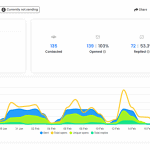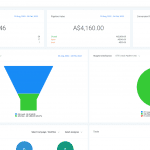[et_pb_section bb_built=”1″ admin_label=”section”][et_pb_row admin_label=”row”][et_pb_column type=”4_4″][et_pb_text admin_label=”Text” background_layout=”light” text_orientation=”left” use_border_color=”off” border_color=”#ffffff” border_style=”solid”]
You’re working with a team of writers, editors, graphic designers and social media gurus to manage multiple blogs – but it’s become time-consuming, messy and downright difficult to keep track of your content and publishing deadlines.
Sound familiar? You’re not alone – so how do we fix it?
The answer is simple: find a tool to help you manage your schedule and workflow. There are plenty of options, but CoSchedule stands out for its tailored yet flexible approach. It’s what we’ve started using recently, and it’s streamlined our content publishing process.
There’s a whole host of functions, including social publishing and content creation – but we’ve found it most useful for the calendar and task management features. Here’s a run-down on how we’re using it to get organised and simplify our content management.
One Calendar for All Upcoming Content



Having a calendar with everything in one place is key to staying on top of deadlines. But all calendars are not created equal, and it was surprisingly hard to find one that could handle our 10 (or more) different client schedules at once, without looking crowded and disorganised. But the CoSchedule calendar manages multiple clients and content types really well, and even when it’s jam-packed it still looks tidy and accessible.
When adding content, you select the type (blog, white paper, case study, etc.) and a label (you create a list of labels using names and colours to represent your different clients), enter a title, and hit “create” then you can add tasks (when you have a template this is just one click) and it’s done! The use of coloured labels makes it visually appealing and separates the different clients so it’s easy to scan and read. It’s also fast and simple to edit any details, which is very handy for those last-minute changes.
Allocate and Complete Tasks

Another problem we needed to solve was how to best allocate the tasks for every piece of content, and communicate to each other when each step was complete.
The CoSchedule workflow templates are brilliant for this purpose – once you’ve set up your template, it takes about 30 seconds to add a new blog post, white paper, etc. to your calendar. The template dates are based on days from the publishing date (i.e.: 28 days from publishing, 14 days from publishing, 7 days, etc.) rather than selecting an actual date, which means you can easily use them as is, or adapt for different clients in a matter of minutes. Your team member will get an email alert the day before any of their tasks are due, and the dashboard provides everyone a birds-eye view of what they each need to get done which is great for planning.
We’ve previously used other collaborating tools, such as Basecamp, and although it is perhaps stronger in other areas (the messaging and to-do lists are great – easy to add, comment on and refer back to) it lacks the ability to show all upcoming content, for all clients together on a calendar in one place for quick reference.
Manage Your Workflow


For our content to get from an idea to being published, there are multiple steps and people involved, and we were looking for a way to simplify how we manage this workflow. We have a couple of different workflows we use depending on the type of content and the client, and with CoSchedule we’ve set up a task template for each. Now it’s as easy as adding the content, selecting a task template and hitting “apply”. In an instant, the content is in the calendar with each task in the workflow assigned to the right person, with dates for completion. Everyone can clearly see where each piece of content is at and we can edit dates if things change, both on the individual task and the content itself, and easily mark as complete when things are done.
Lots of Potential
Today, there are a multitude of tools available to manage and collaborate workflows. Some take a lot of time and effort to manage, while others bring an immediate sense of organisation to the table. CoSchedule falls into the latter – it’s both practical and easy to use, and you can include a lot of information without it becoming cluttered or messy to manage. And what’s more, we’re only using a fraction of the functions available –our social messaging and drafting and publishing of content is done through HubSpot, but CoSchedule can handle this too – which means there is loads of potential to get even more out of it in the future.
Over to You
Have you found an effective online organisational tool? And do you have a favourite function or feature? We’d love you to share in the comments below.
——————————————————————-
Tired of DISORGANISATION when it comes to your content marketing schedule? Download our free content marketing editorial calendar template to keep your publishing schedule on track and organised.
[/et_pb_text][/et_pb_column][/et_pb_row][/et_pb_section]
- How Videos Can Be Used in Email Marketing for More Engagement - April 4, 2022
- Attention Home Builders: Here’s How to Educate, Engage and Win Over Potential Customers - October 19, 2020
- The Best Digital Marketing Framework for High Ticket Businesses - September 14, 2020








Thanks for the awesome review! We really appreciate it. 🙂
No worries, Brock. Great software.